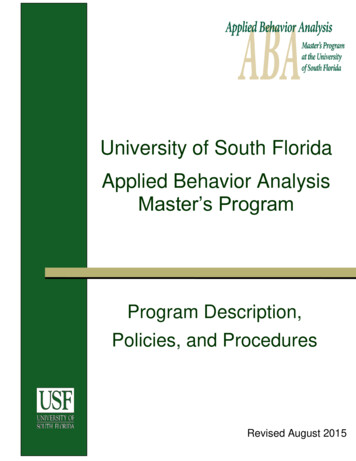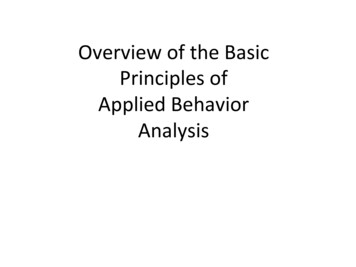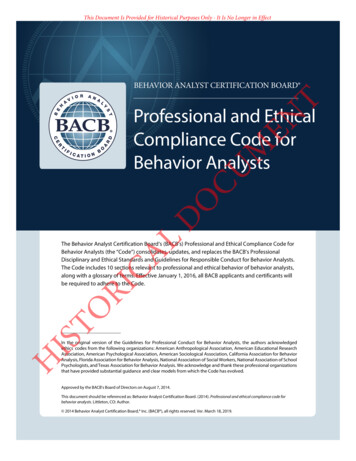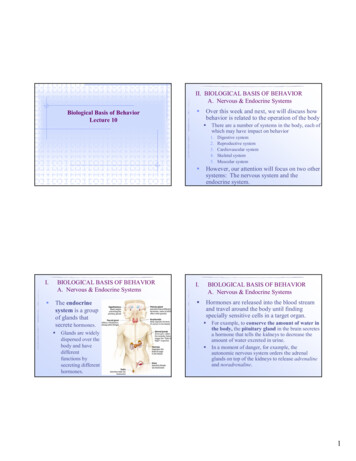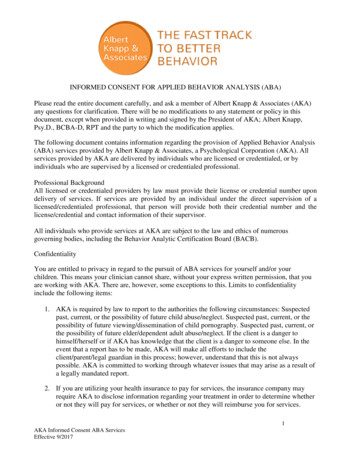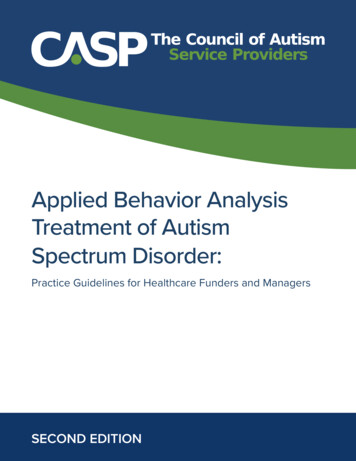
Transcription
Applied Behavior AnalysisTreatment of AutismSpectrum Disorder:Practice Guidelines for Healthcare Funders and ManagersSECOND EDITION
These standards are provided for informational purposes only and do not representprofessional or legal advice. There are many variables that influence and direct theprofessional delivery of Applied Behavior Analysis (ABA) services. The Council of AutismService Providers (CASP) and authors of these standards assume no liability or responsibilityfor application of these standards in the delivery of ABA services. The standards presentedin this document reflect the consensus of a number of subject matter experts, but do notrepresent the only acceptable practice. These standards also do not reflect or create anyaffiliation among those who participated in their development. CASP does not warrant orguarantee that these standards will apply or should be applied in all settings. Instead, thesestandards are offered as an informational resource that should be considered in consultationwith parents, behavior analysts, regulators, and healthcare funders and managers.Copyright 2014, 2020 by The Council of Autism Service Providers (“CASP”). Ver. 2.0Electronic and/or paper copies of part of all of this work may be made for personal, educational, or policymaking purposes, provided suchcopies are not made or distributed for profit or commercial advantage. All copies, regardless of medium, must include this note on the firstpage. Abstracting with proper credit is permitted, so long as the credit reads “Copyright 2020 by The Council of Autism Service Providers(CASP), all rights reserved.” All other uses and/or distributions in any medium require advance permission of The Council of Autism ServiceProviders (“CASP”), available from info@casproviders.org.
TABLE OF CONTENTSPART I: OverviewSECTION 1: Executive Summary .3SECTION 2: Autism Spectrum Disorder and Applied Behavior Analysis .4SECTION 3: Considerations .5PART II: Unique Features Of Applied Behavior AnalysisSECTION 1: Training and Credentialing of Behavior Analysts .6SECTION 2: Applied Behavior Analysis in the Treatment of AutismSpectrum Disorder .10SECTION 3: Assessment, Formulation of Treatment Goals, andMeasurement of Client Progress .19SECTION 4: Service Authorization and Dosage .22SECTION 5: Tiered Service-delivery Models and Behavior Technicians .26SECTION 6: Case Supervision . 31SECTION 7: Working with Caregivers and Other Professionals .36SECTION 8: Discharge, Transition Planning, and Continuity of Care .40PART III: AppendicesAPPENDIX A: Eligibility Requirements for BACB Certification .41APPENDIX B: Selected Bibliography .44APPENDIX C: Footnotes .452
PART I:OverviewSECTION 1:EXECUTIVE SUMMARYThe purpose of this document is to inform decision-making regarding the use of Applied Behavior Analysis(ABA) to treat medically necessary conditions so as to develop, maintain, or restore, to the maximum extentpracticable, the functioning of individuals with Autism Spectrum Disorder (ASD) in ways that are bothefficacious and cost effective.1The document is based on the best available scientific evidence and expert clinical opinion regarding the useof ABA as a behavioral health treatment for individuals diagnosed with ASD. The guidelines are intendedto be a brief and user-friendly introduction to the delivery of ABA services for ASD. These guidelines arewritten for healthcare funders and managers, such as insurance companies, government health programs,employers, among others. The guidelines may also be useful for consumers, service providers, andregulatory bodies.This document provides clinical guidelines and other information about ABA as a treatment for ASD. As abehavioral health treatment, ABA includes a number of unique clinical and delivery components. Thus, it isimportant that those charged with building a provider network understand these unique features of ABA.This is the second edition of this resource manual and it will continue to be periodically updated to reflectchanges in clinical practice and research findings. Additional references and information can be found in theappendices.3
SECTION 2:AUTISM SPECTRUM DISORDERAND APPLIED BEHAVIOR ANALYSIS1What Is ASD?ASD is characterized by varying degrees of difficulty in social interaction and verbal and nonverbalcommunication, and the presence of repetitive behavior and/or restricted interests.2 Due to the variabilityand symptom presentation, no two individuals with an ASD diagnosis are the same with respect to how thedisorder manifests and its impact on families. Because of the nature of the disorder, people with ASD oftenwill not achieve the ability to function independently without appropriate medically necessary treatment.2What Is ABA?ABA is a well-developed scientific discipline among the helping professions that focuses on the analysis,design, implementation, and evaluation of social and other environmental modifications to producemeaningful changes in human behavior. ABA includes the use of direct observation, measurement, andfunctional analysis of the relations between environment and behavior. ABA uses changes in environmentalevents, including antecedent stimuli and consequences, to produce practical and significant changesin behavior. These relevant environmental events are usually identified through a variety of specializedassessment methods. ABA is based on the fact that an individual’s behavior is determined by past andcurrent environmental events in conjunction with organic variables such as their genetic endowment andphysiological variables. Thus, when applied to ASD, ABA focuses on treating the problems of the disorder byaltering the individual’s social and learning environments.The current guidelines are specific to ABA as a behavioral health treatment of ASD. Nevertheless, ABA has alsobeen demonstrated as effective for treating the symptoms of a variety of conditions, including severe destructivebehavior, substance abuse, dementia, pediatric feeding disorders, traumatic brain injury, among others.The successful remediation of core deficits of ASD, and the development or restoration of abilities,documented in hundreds of peer-reviewed studies published over the past 50 years, has made ABA thestandard of care for the treatment of ASD (see Appendix B).4
SECTION 3:CONSIDERATIONS This document contains guidelines and recommendations that reflect established researchfindings and best clinical practices. However, individualized treatment is a defining feature andintegral component of ABA, which is one reason why it has been so successful in treating thisheterogeneous disorder. Some individuals diagnosed with ASD have co-occurring conditions including, but not limited to,intellectual disabilities, seizure disorders, psychiatric disorders, chromosomal abnormalities, feedingdisorders, sleep disorders, elimination disorders, destructive behavior (for example, self-injury,aggression), and a variety of other conditions that require additional medical treatment. Theseguidelines apply to individuals diagnosed with ASD with these co-occurring conditions, asresearch has established ABA as effective for these client populations as well. The guidelines in this document are pertinent to the use of ABA as a behavioral health treatment todevelop, maintain, or restore, to the maximum extent practicable, the functioning of an individualwith ASD. These guidelines should not be used to diminish the availability, quality, or frequency of currentlyavailable ABA treatment services. Coverage of ABA treatment for ASD by healthcare funders and managers should not supplantresponsibilities of educational or governmental entities. Specification of ABA in an educational or government program should not supplant ABA coverageby healthcare funders and managers. ABA treatment must not be restricted a priori to specific settings but instead should be delivered inthose settings that maximize treatment outcomes for the individual client. This document provides guidance regarding ABA treatment only; other behavioral health treatmentsare not addressed.5
PART II:Unique Features ofApplied Behavior AnalysisSECTION 1:TRAINING AND CREDENTIALINGOF BEHAVIOR ANALYSTSABA is a specialized behavioral health treatment approach and most graduate or postgraduate trainingprograms in psychology, counseling, social work, or other areas of clinical practice do not provide in-depthtraining in this discipline. Thus, an understanding of the credentialing process of Behavior Analysts by theBehavior Analyst Certification Board (BACB ) can assist health plans and their subscribers in identifyingthose providers who meet the basic competencies to practice ABA.The formal training of professionals certified by the BACB is similar to that of other medical and behavioralhealth professionals. That is, they are initially trained within academia and then begin working in asupervised clinical setting with clients. As they gradually demonstrate the competencies necessary tomanage complex clinical problems across a variety of clients and medical environments, they becomeindependent practitioners. In summary, Behavior Analysts undergo a rigorous course of training andeducation, including an “internship” period in which they work under the direct supervision of anexperienced Behavior Analyst.It should be noted that other licensed professionals may have ABA included within their particular scope oftraining and competence. In addition, a small subset of clinicians may be licensed by another profession andalso hold a credential from the BACB, thereby providing additional evidence of the nature and depth of theirtraining in ABA.Although healthcare funding and management of behavioral health treatments supervised by BehaviorAnalysts is relatively recent, Behavior Analysts–like other medical and behavioral health providers–rely uponstrategies and procedures documented in peer-reviewed literature, established treatment protocols, andclinical decision-making frameworks. They continually evaluate the current state of the client and customizetreatment options based on the results of direct observation and data from a range of other assessments.Behavior Analysts also solicit and integrate information from the client and family members and coordinatecare with other professionals.6
The Behavior Analyst Certification BoardThe BACB is a nonprofit 501(c)(3) corporation established to meet professional credentialing needs identifiedby Behavior Analysts, governments, and consumers of behavior analysis services. The mission of the BACB isto protect consumers of behavior analysis services worldwide by systematically establishing, promoting, anddisseminating professional standards. The BACB has established uniform content, standards, and criteria forthe credentialing process that are designed to meet: The legal standards established through state, national, and case law; The accepted standards for certification programs; and The “best practice” and ethical standards of the behavior analysis profession.The BCBA and BCaBA certification programs are currently accredited by the National Commission forCertifying Agencies (NCCA), the accreditation arm of the Institute for Credentialing Excellence. NCCAreviews and oversees all aspects related to ensuring the development and application of appropriatecredentialing processes.The BACB credentials and recognizes practitioners at four levels:DOCTORALMASTER’SBACHELOR’SHIGH SCHOOLRegistered BehaviorTechnician RBT Board CertifiedAssistant BehaviorAnalyst BCaBA Board CertifiedBehaviorAnalyst BCBA Board CertifiedBehaviorAnalyst – Doctoral BCBA-D Practitioners credentialed at the BCBA-D and BCBA levels are defined as Behavior Analysts. The BACB requiresthat BCaBAs, or Assistant Behavior Analysts, work under the supervision of a BCBA-D or BCBA. RBTs mustwork under the supervision of a BCBA-D, BCBA, or BCaBA. Note: requirements for the RBT credential aredescribed in Section 5 (Tiered Service-Delivery Models and Behavior Technicians).7
Eligibility Requirements for Behavior Analysts & Assistant Behavior AnalystsApplicants who meet the degree, coursework, and supervised experience eligibility requirements describedin the next section are permitted to sit for either the BCBA or BCaBA examination (see figure below). Eachexamination is professionally developed to meet accepted examination standards and is based on the resultsof a formal job analysis and survey. In addition, all BACB examinations are offered under secure testing conditions and are professionally administered and mary requirements for certification by the BACB.8
Continuing Education and Maintaining CertificationBACB certificants are required to attest to theircompliance with the organization’s ethical anddisciplinary rules (see below) on a biennial basisand obtain 20 (BCaBA) or 32 (BCBA, BCBA-D)hours* of continuing education every two years, 4hours of which must relate to professional ethics.Organizations that employ Behavior Analysts andAssistant Behavior Analysts should support andprovide this training as needed.BCaBABCBABCBA-D20hours*32hours**continuing ed. credits every 2 yearsDisciplinary ProceduresAll certificants must regularly report any matter that might impact their ethical compliance. The BACB’sethical requirements may be found at www.bacb.com.The BACB uses an online complaint system by which the organization is alerted to potential disciplinaryviolations. Each complaint is evaluated by the BACB legal department and then, based on its merit, isforwarded to a committee for review and processing. The committee members are senior BCBAs orBCBA-Ds selected for their knowledge and independence, and when advisable, includes a member from thecertificant’s region. Disciplinary actions for certificants include, but are not limited to, advisory consultation,mandated continuing education, suspension of certification, or revocation of certification. Resultingdisciplinary actions are publicly reported online.Licensure of Behavior AnalystsBACB certification credentials or standards are currently the basis for licensure in the U.S. states whereBehavior Analysts are licensed. Basing licensure on BACB credentials is cost effective and ensures thatcritical competencies regarding practice and research are periodically reviewed and updated by practitionersand researchers. Whether it is used as the basis for licensure or as a “free-standing” credential, BACBcertification credentials are recognized in those states where insurance reform laws have been enacted andin other states as well.9
SECTION 2:APPLIED BEHAVIOR ANALYSIS IN THE TREATMENTOF AUTISM SPECTRUM DISORDERApplied Behavior Analysis is a well-developed discipline among the helping professions, with a maturebody of scientific knowledge, established standards for evidence-based practice, distinct methods of servicedelivery, recognized experience and educational requirements for practice, and identified sources of requisiteeducation in universities. Professionals in ABA engage in the specific and comprehensive use of principles oflearning, including operant and respondent learning, to address the needs of individuals with ASD in diversesettings. Services are provided and supervised by Behavior Analysts with expertise and formal training inABA for the specific treatment of ASD.1Identifying ABAHealthcare funders and managers must be able to recognize the following core characteristics of ABA:1. An objective assessment and analysis of the client’s condition by observing how theenvironment affects the client’s behavior, as evidenced through appropriate data collection.2. Importance given to understanding the context of the behavior and the behavior’s value to theindividual, the family, and the community.3. Utilization of the principles and procedures of behavior analysis such that the client’s health,independence, and quality of life are improved.4. Consistent, ongoing, objective assessment and data analysis to inform clinical decision-making.10
2Essential Practice Elements Of ABAThe four core characteristics listed above should be apparent throughout all phases of assessment andtreatment in the form of these essential practice elements:1. Comprehensive assessment that describes specific levels of behavior at baseline and informssubsequent establishment of treatment goals2. An emphasis on understanding the current and future value (or social importance) of behavior(s)targeted for treatment.3. A practical focus on establishing small units of behavior that build towards larger, more significantchanges in functioning related to improved health and levels of independence.4. Collection, quantification, and analysis of direct observational data on behavioral targets duringtreatment and follow-up to maximize and maintain progress toward treatment goals.5. Efforts to design, establish, and manage the social and learning environment(s) to minimizeproblem behavior(s) and maximize rate of progress toward all goals.6. An approach to the treatment of problem behavior that links the function of (or the reason for) thebehavior to the programmed intervention strategies.7. Use of a carefully constructed, individualized and detailed behavior-analytic treatmentplan that utilizes reinforcement and other behavioral principles and excludes the use of methodsor techniques that lack consensus about their effectiveness based on evidence in peer-reviewedpublications.8. Use of treatment protocols that are implemented repeatedly, frequently, and consistentlyacross environments until discharge criteria are met.9. An emphasis on ongoing and frequent direct assessment, analysis, and adjustments to thetreatment plan (by the Behavior Analyst) based on client progress as determined by observations andobjective data analysis.10.Direct support and training of family members and other involved professionals to promoteoptimal functioning and promote generalization and maintenance of behavioral improvements.11. A comprehensive infrastructure for supervision of all assessment and treatment by a BehaviorAnalyst.11
3Treatment ModelsABA treatment programs for ASD incorporate findings from hundreds of applied studies focused onunderstanding and treating ASD published in peer-reviewed journals over a 50-year span. Treatment mayvary in terms of intensity and duration, the complexity and range of treatment goals, and the extent of directtreatment provided. Many variables, including the number, complexity, and intensity of behavioral targets andthe client’s own response to treatment help determine which model is most appropriate. Although existingon a continuum, these differences can be generally categorized as one of two treatment models: Focused orComprehensive ABA Treatment.3Focused ABA TreatmentService DescriptionFocused ABA refers to treatment provided directly to the client for a limited number of behavioral targets. Itis not restricted by age, cognitive level, or co-occurring conditions.Focused ABA treatment may involve increasing socially appropriate behavior(for example, increasing social initiations) or reducing problem behavior (forexample, aggression) as the primary target. Even when reduction of problembehavior is the primary goal, it is critical to also target increases in appropriatealternative behavior, because the absence of appropriate behavior is often theprecursor to serious behavior disorders. Therefore, individuals who need toacquire skills (for example, communication, tolerating change in environmentsand activities, self-help, social skills) are also appropriate for Focused ABA.Focused ABA treatmentmay involve increasingsocially appropriatebehavior or reducingproblem behavior.Focused ABA plans are appropriate for individuals who (a) need treatment onlyfor a limited number of key functional skills or (b) have such acute problem behavior that its treatment shouldbe the priority.Examples of key functional skills include, but are not limited to, establishing instruction-following, socialcommunication skills, compliance with medical and dental procedures, sleep hygiene, self-care skills,safety skills, and independent leisure skills (for example, appropriate participation in family and communityactivities). Examples of severe problem behaviors requiring focused intervention include, but are not limited12
Treatment Models › Focused ABA Treatment, cont.to, self-injury, aggression, threats, pica, elopement, feeding disorders, stereotypic motor or vocal behavior,property destruction, noncompliance and disruptive behavior, or dysfunctional social behavior.When prioritizing the order in which to address multiple treatment targets, the following should beconsidered: Behavior that threatens the health or safety of the client or others or that constitutesa barrier to quality of life (for example, severe aggression, self-injury, property destruction, ornoncompliance); Absence of developmentally appropriate adaptive, social, or functional skills that arefundamental to maintaining health, social inclusion, and increased independence(for example, toileting, dressing, feeding, and compliance with medical procedures).When the focus of treatment involves increasing socially appropriate behavior, treatment may be deliveredin either an individual or small-group format. When conducted in a small group, typically developing peersor individuals with similar diagnoses may participate in the session. Members of the behavior-analytic teammay guide clients through the rehearsal and practice of behavioral targets with each other. As is the casefor all treatments, programming for generalization of skills outside the session is critical.When the focus of treatment involves the reduction of severe problem behavior, the Behavior Analyst willdetermine which situations are most likely to precipitate problem behavior and, based on this information,begin to identify its potential purpose (or “function”). This may require conducting a functional analysisprocedure to empirically demonstrate the function of the problem behavior. The results enable the BehaviorAnalyst to develop the most effective treatment protocol. When the function of the problem behavioris identified, the Behavior Analyst will design a treatment plan that alters the environment to reduce themotivation for problem behavior and/or establish a new and more appropriate behavior that serves thesame function and therefore “replaces” the problem behavior.13
Treatment Models › Focused ABA Treatment, cont.In some cases, individuals with ASD display co-occurring severe destructive behavior disorders that requirefocused treatment in more intensive settings, such as specialized intensive-outpatient, day-treatment,residential, or inpatient programs. In these cases, these behavior disorders are given separate and distinctdiagnoses (for example, Stereotypic Movement Disorder with severe self-injurious behavior). The ABA servicesdelivered in these settings typically require higher staff-to-client ratios (for example, two to three staff for eachclient) and close on-site direction from the Behavior Analyst. In addition, such treatment programs often havespecialized treatment environments (for example, treatment rooms designed for observation and to keep theclient and the staff as safe as possible).Comprehensive ABA TreatmentService DescriptionComprehensive ABA refers to treatment of the multiple affected developmental domains, such as cognitive,communicative, social, emotional, and adaptive functioning. Maladaptive behaviors, such as noncompliance,tantrums, and stereotypy are also typically the focus of treatment. Although there are different types ofcomprehensive treatment, one example is early intensive behavioral intervention where the overarchinggoal is to close the gap between the client’s level of functioning and that of typically developing peers.These programs tend to range from 30-40 hours of treatment per week (plus direct and indirect supervisionand caregiver training). Initially, this treatment model typically involves 1:1 staffing and gradually includessmall-group formats as appropriate. Comprehensive treatment may also be appropriate for older individualsdiagnosed with ASD, particularly if they engage in severe or dangerous behaviors across environments.Initially, treatment is typically provided in structured therapy sessions, which are integrated with morenaturalistic methods as appropriate. As the client progresses and meets established criteria for participationin larger or different settings, treatment in those settings and in the larger community should be provided.Training family members and other caregivers to manage problem behavior and to interact with theindividual with ASD in a therapeutic manner is a critical component of this treatment model.14
Treatment Models › Comprehensive ABA Treatment, cont.Typical Program ComponentsTreatment components should generally be drawn from the following areas (ordered alphabetically): adaptive and self-care skills play and leisure skills attending and social referencing pre-academic skills cognitive functioning reduction of interfering or inappropriate behaviors community participation safety skills coping and tolerance skills self-advocacy and independence emotional development self-management family relationships social relationships language and communication vocational skillsFor information on treatment intensity and duration for various Focused and Comprehensive Treatments, seeSection 4 (Service Authorization and Dosage).4Variations Within These ModelsTreatment programs within any of these models vary along several programmatic dimensions, includingthe degree to which they are primarily provider- or client-directed (sometimes described as “structuredvs. naturalistic”). Other variations include the extent to which peers or parents are involved in the deliveryof treatment. Finally, some differ in terms of the degree to which they are “branded” and availablecommercially.Decisions about how these various dimensions are implemented within individual treatment plans mustreflect many variables, including the research base, the age of the client, specific aspects of the targetbehaviors, the client’s rate of progress, demonstration of prerequisite skills, and resources required tosupport implementation of the treatment plan across settings.15
5ABA Procedures Employed In These ModelsA large number of ABA procedures are routinely employed within the models previously described. Theydiffer from one another in their complexity, specificity, and the extent to which they were designed primarilyfor use with individuals diagnosed with ASD. All are based on the principles of ABA and are employed withflexibility determined by the individual’s specific treatment plan and response to treatment. If one ABAprocedure or combination of ABA procedures is not producing the desired outcomes, a different one maybe systematically implemented and evaluated for its effectiveness.These procedures include different types of reinforcement and schedules of reinforcement, differentialreinforcement, shaping, chaining, behavioral momentum, prompting and fading, behavioral skills training,extinction, functional communication training, discrete-trial teaching, incidental teaching, self-management,functional assessment, preference assessments, activity schedules, generalization and maintenanceprocedures, among many others (see the BACB Fourth Edition Task List). The field of behavior analysis isconstantly developing and evaluating applied behavior-change procedures.16
6Locations Where Treatment Is DeliveredThe standard of care provides for treatment to be delivered consistently in multiple settings to promotegeneralization and maintenance of therapeutic benefits. No ABA model is specific to a particular locationand all may be delivered in a variety of settings, including residential treatment facilities, inpatient andoutpatient programs, homes, schools, transportation, and places in the community. Treatment acrosssettings with multiple adults, siblings, and/or typically developing peers, under the supervision of a BehaviorAnalyst, supports generalization and maintenance of treatment gains. It should be noted that treatmentmight occur in multiple settings (for example, home, community, and transportation) on the same day.Treatment should not be denied or withheld because a caregiver cannot be at the treatment locationconsistently.To ensure continuity of care, sufficient ABA treatment and consultation should be delivered in subsequenteducational and therapeutic settings (for example, residence to school, hospital to home) to successfullysupport and transition individuals.POSSIBLE TREATMENTLOCATIONLOCATIONSTREATMENT MODELSTREATMENTMODELHOMESCHOOL ATIENTFOCUSEDCOMPREHENSIVE17
7Client AgeTreatment should be based on the clinical needs of the individual and notconstrained by age. Consistent ABA treatment should be provided as soonas possible after diagnosis, and in some cases services are warranted priorto diagnosis. There is evidence that the earlier treatment begins, the great
by Behavior Analysts, governments, and consumers of behavior analysis services. The mission of the BACB is to protect consumers of behavior analysis services worldwide by systematically establishing, promoting, and disseminating professional standards. The BACB has
